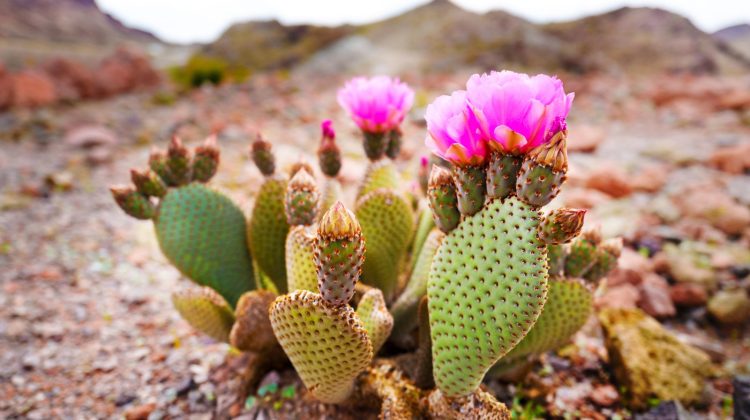
Imagine walking through a seemingly endless expanse of sand and stone, only to stumble upon a vibrant canvas of color that springs forth from the earth.
In the heart of desert landscapes, such as the arid stretches of Death Valley or the Mojave Desert, you find a rare and magical event known as a superbloom.
These blooms are not only spectacular to witness but are also vital to the desert ecosystem.
You may have heard of Anza-Borrego Desert State Park or Joshua Tree National Park, celebrated destinations in Southern California where wildflower seasons paint the terrain with a stunning array of desert wildflowers.
These natural phenomena, driven by just the right combination of rain and temperature, are a testament to the resilience of desert plants.
Superblooms draw visitors from near and far, highlighting the importance of conservation efforts to preserve these uniquely adapted species.
In this article, we'll cover
- 1. Saguaro Cactus Flower
- 2. Desert Lily
- 3. Prickly Pear Cactus Flower
- 4. Ocotillo
- 5. Desert Marigold
- 6. Sand Verbena
- 7. Desert Sunflower
- 8. Mexican Gold Poppy
- 9. Desert Rose
- 10. Globe Mallow
- 11. Joshua Tree
- 12. Chuparosa
- 13. Penstemon
- 14. Red Yucca
- 15. Brittlebush
- 16. Mojave Aster
- 17. Fishhook Barrel Cactus Flower
- 18. Chocolate Daisy
- 19. Blue Palo Verde
- 20. Ghost Flower
1. Saguaro Cactus Flower
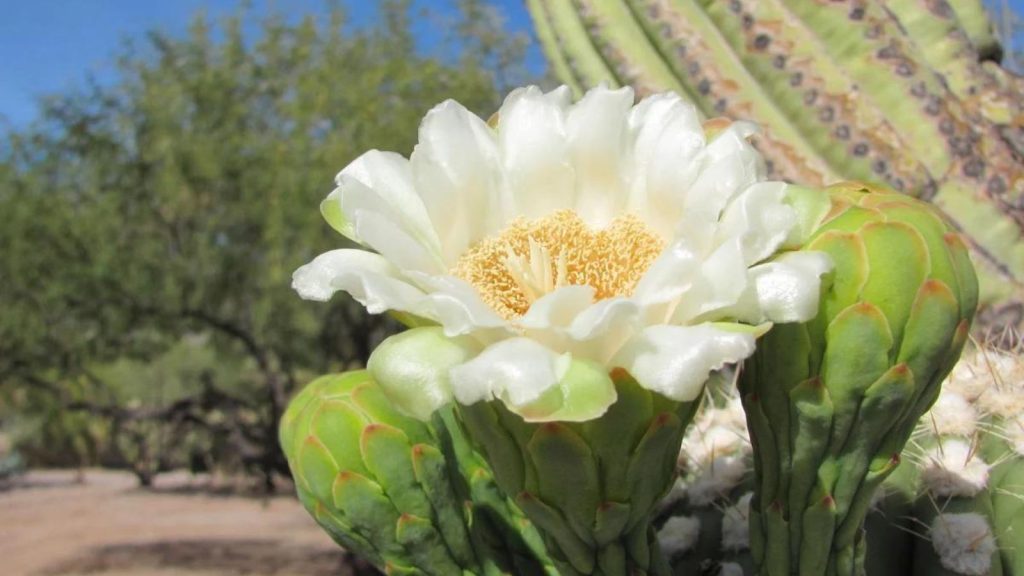
In the vast expanse of Arizona’s deserts, you’ll find the iconic saguaro cactus standing tall.
Among the thorny landscape, a flower of unique beauty blooms: the saguaro cactus flower.
- Symbolizing the state, this white blossom reveals a waxy surface, contrasting against the arid backdrop.
- Appearance: Delicate yet hardy, each flower offers a stark white palette with a yellow center.
- Timing: Typically, they make their annual debut in late spring.
- Location: Specifically, visit Saguaro National Park to witness these flowers crowning the cacti.
As you wander the flowering desert, notice how these succulents, despite harsh conditions, punctuate the landscape with bursts of life.
They are a reminder of the resilience and unexpected beauty found in nature.
2. Desert Lily

In the expansive deserts of the Southwestern United States, you’ll encounter the striking Hesperocallis undulata, commonly known as the Desert Lily.
This bulbous plant graces the arid landscape with its pristine white flowers. When in bloom, it’s a sight that artistically contrasts the rugged terrain.
The Desert Lily blooms in response to the right temperature and moisture, a phenomenon of the wildflower season that brings life to the otherwise dormant terrain.
Its presence is often celebrated among the colorful wildflowers that punctuate the desert’s canvas.
Caring for these lilies is straightforward as they thrive under arid conditions, laying seeds that ensure the return of their delicate beauty year after year.
For an awe-inspiring wildflower viewing experience, the bloom period of the Desert Lily is a perfect time to explore.
3. Prickly Pear Cactus Flower
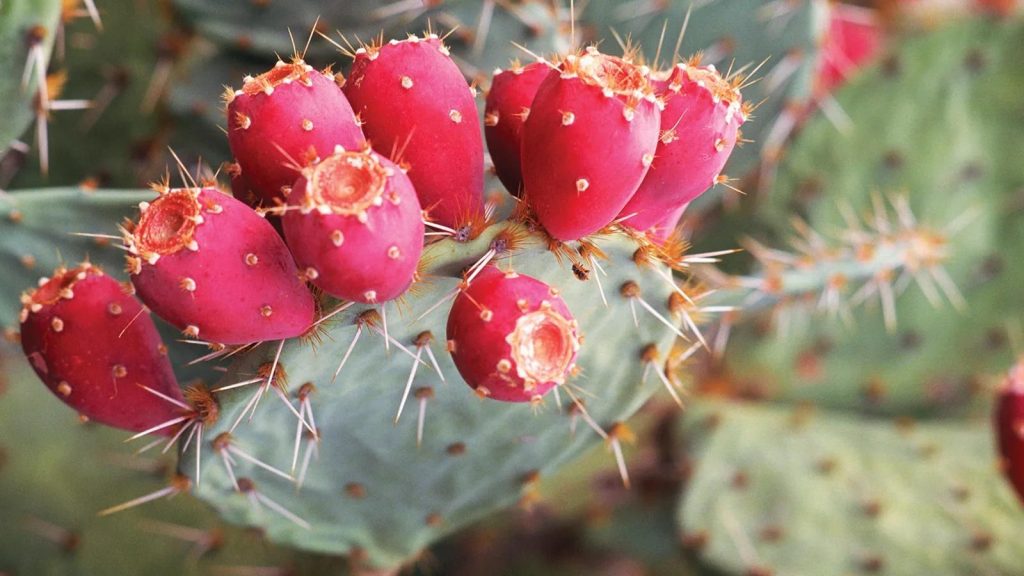
Prickly pear cacti grace the Arizona desert with a spectacular display of colorful blooms.
Come wildflower season, these hardy plants brighten the typically arid landscape.
In the warmth of spring and early summer, you’ll witness them bursting with vibrant hues—yellows, oranges, pinks, and reds.
Temperature plays a crucial role in their flowering, as mild warmth encourages the blooms.
When in flower, the prickly pear is not just a sight to behold but also a key nourishment source for desert wildlife.
Amid the various cacti, the prickly pear stands out, its flowers contributing to the dazzling flowering desert.
Next to the brittlebush and beavertail cactus, the prickly pear is an iconic symbol of resilience in arid conditions.
Even ephemerals, like the desert primrose, accompany these cacti, creating a symphony of desert flowers.
Keep an eye out for updates during the blooming months to catch these wonders in their prime.
4. Ocotillo
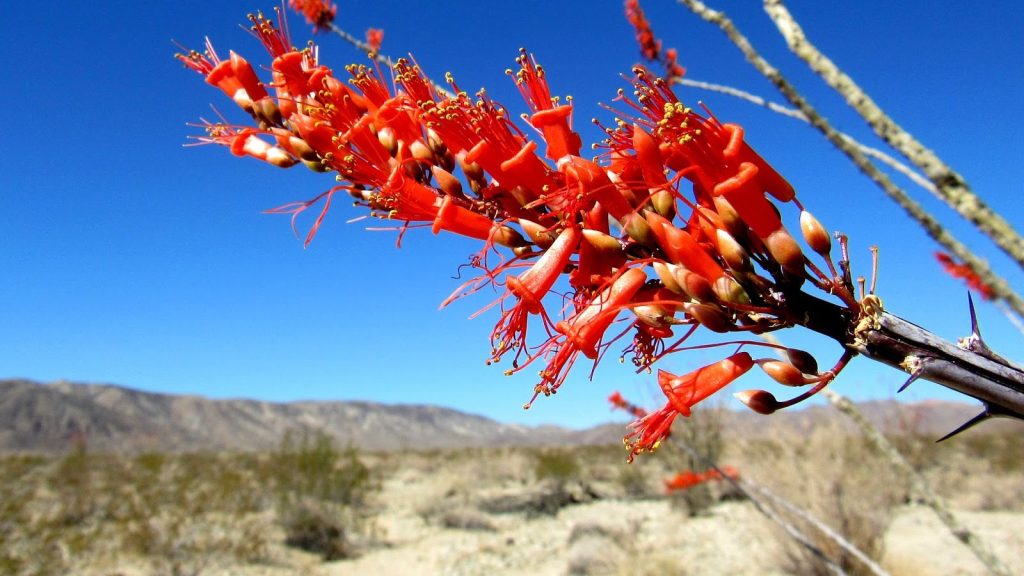
Imagine spiky, wand-like branches reaching toward the sky, and you’ve conjured the Ocotillo (Fouquieria splendens), a desert gem that thrives in arid conditions.
- Growth: Vase-shaped with tall, thorny stems.
- Height: Typically 8 to 20 feet.
- Spread: 5 to 10 feet wide.
- Blooms: Bright red, tubular flowers.
Your encounter with this desert flower is a treat for the senses.
As the blooms burst forth, they signal a feast for local pollinators.
Hummingbirds and bees are especially drawn to the nectar-rich blossoms.
The flowering season brings this desert dweller to life, transforming the arid landscape into a colorful palette of wildflowers.
5. Desert Marigold
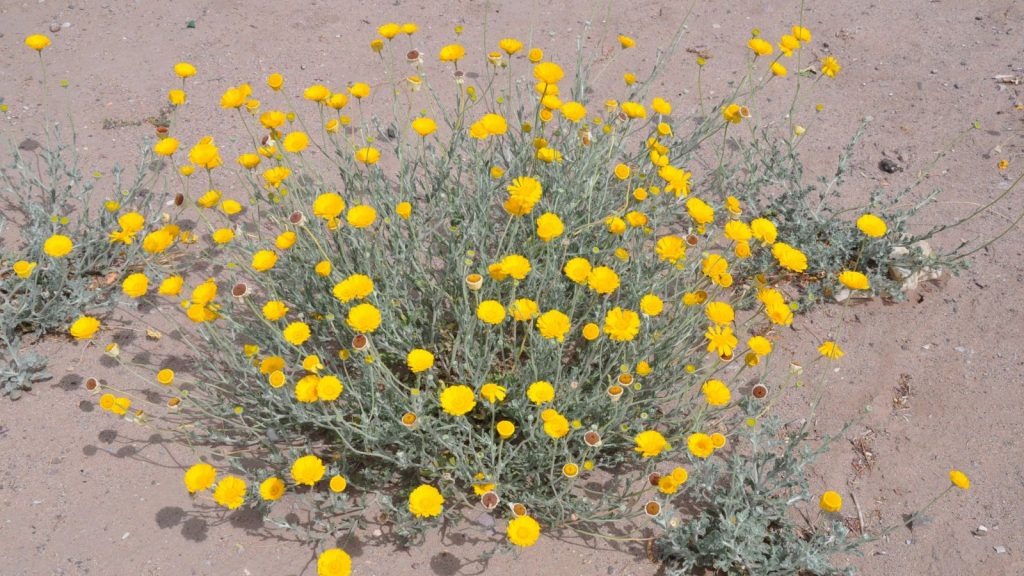
When you wander through the Southwestern deserts of the United States, especially during the wildflower season, you might encounter the Desert Marigold (Baileya multiradiata).
This cheerful wildflower thrives in the harsh desert conditions of places like Arizona.
With its radiant yellow blooms, the Desert Marigold creates a stunning contrast against the brittlebush and prickly pear that commonly dot the landscape.
- Temperature Tolerance: Highly adapted to arid climates.
- Bloom Cycle: Peaks during spring; can re-bloom after summer rains.
- Growing Conditions: Prefers well-drained soils in full sun.
In your own desert landscape, these wildflowers can establish themselves, becoming a naturalized part of the ecosystem.
To propagate, simply allow the spent flowers to drop their seeds, which will lie dormant until conditions are right for the next burst of color.
However, if continuous blooming is what you desire, removal of dead flowers—known as deadheading—encourages further blooming, letting you enjoy the vivid display longer.
6. Sand Verbena
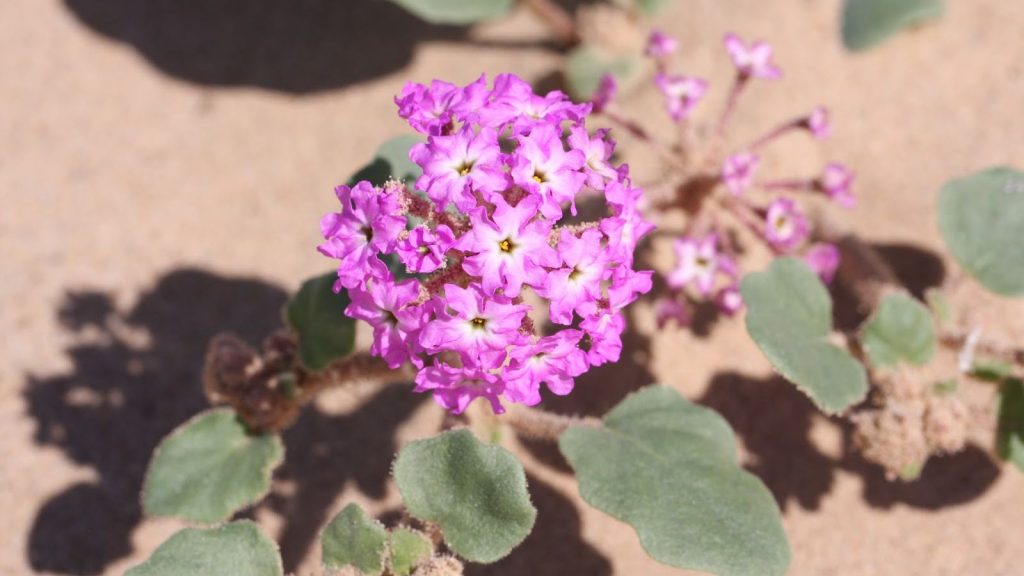
In the heart of arid deserts, Sand Verbena (Abronia spp.) enchants with clusters of striking pink and purple blooms.
Thriving under the harsh sun, these desert flowers adapt to extreme temperatures, dotting the landscape with a splash of color.
Key Features:
- Color: Pink/purple
- Bloom Period: Generally February to May
- Habitat: Sandy, desert regions
As you wander through the desert, you might be lucky enough to witness these hardy plants.
Abronia spp. often spread across the sand creating a floral carpet that’s as resilient as it is beautiful.
They’re a testament to the vibrant life that flourishes even in challenging conditions.
Keep an eye out during your desert treks for these gems that redefine the desert landscape.
7. Desert Sunflower
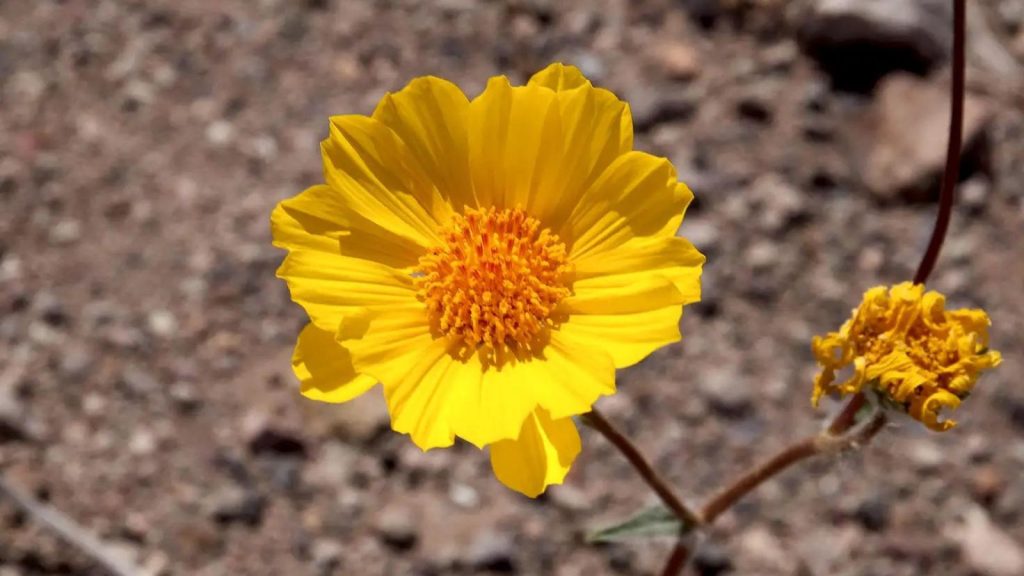
When you wander through the seemingly lifeless desert landscape, a surprising burst of color might catch your eye, especially post-rainfall.
The Desert Sunflower, or Geraea canescens, is like a sunny herald of wildflower season.
Its bright yellow petals stand out starkly against the arid conditions, bringing a sense of warmth and cheer to the desert flowers that dot the region.
Typically found in California, alongside vibrant poppies, the Desert Sunflower contributes to the phenomenon known as super bloom.
This breathtaking display occurs when the right conditions coax a multitude of flowers to life, transforming the desert landscape into a canvas of colors.
To experience these radiant blooms, plan your visit during the peak bloom season.
But remember, while Geraea canescens resembles the sunflowers you might find in a garden, these are uniquely adapted to thrive in the desert’s challenging environment.
8. Mexican Gold Poppy
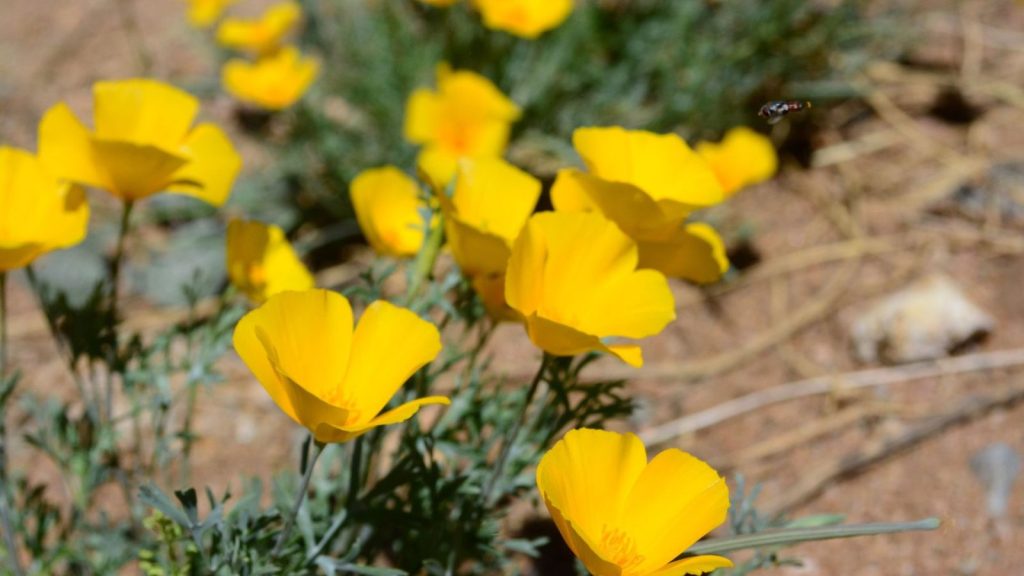
The Mexican Gold Poppy (Eschscholzia californica ssp. mexicana) transforms the landscapes of Arizona and California each spring.
You’ll find these vibrant orange-yellow blossoms offering a warm welcome amidst the arid expanses.
Where to Enjoy Them:
- Arizona: Breathtaking locales await your visit. Areas like the Catalina State Park are renowned for their wildflower displays, with the Sutherland Trail being particularly noteworthy.
- California: Here, you might witness the Mexican Gold Poppies alongside their kin, the California poppies, especially during a super bloom.
Growth and Dormancy:
- These poppies flaunt their cup-shaped flowers when conditions are right. Interestingly, they close at night or during overcast weather, and their seeds can remain dormant until the next favorable season.
9. Desert Rose
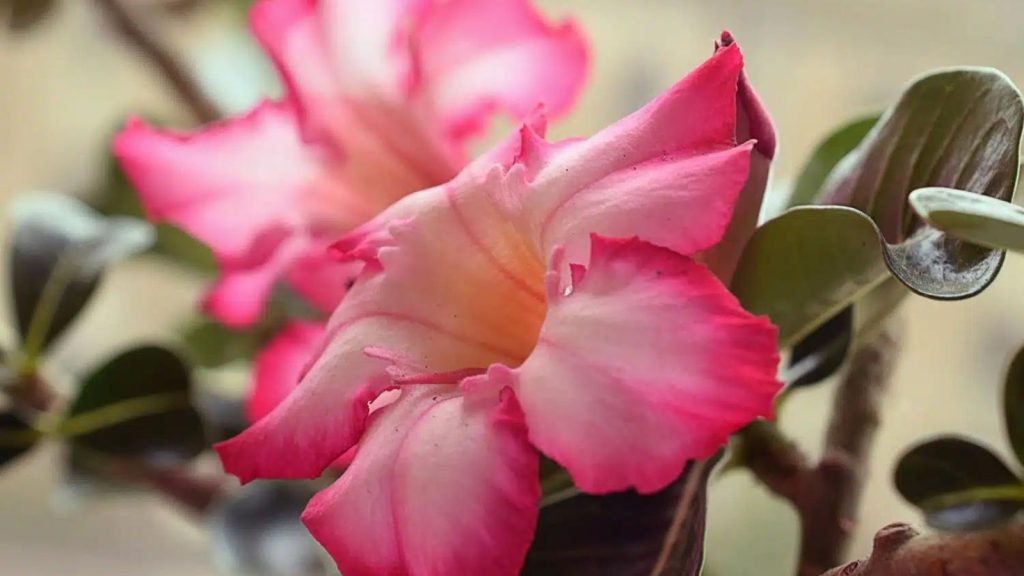
Adenium obesum, popularly known as the Desert Rose, is not your typical bloomer.
Native to Africa and the Arabian Peninsula, this succulent plant captivates with its pink and white flowers.
Thriving in arid climates, it’s perfect for adding a touch of exotic charm to your landscape.
Characteristics of the Desert Rose:
- Flowers: Bold, trumpet-shaped that range from vivid pink to white.
- Leaves: Glossy and dark green in contrast to the stout, swollen trunk.
- Habitat: Enjoys hot, sunny spaces – think Arizona deserts, where it’s right at home.
10. Globe Mallow
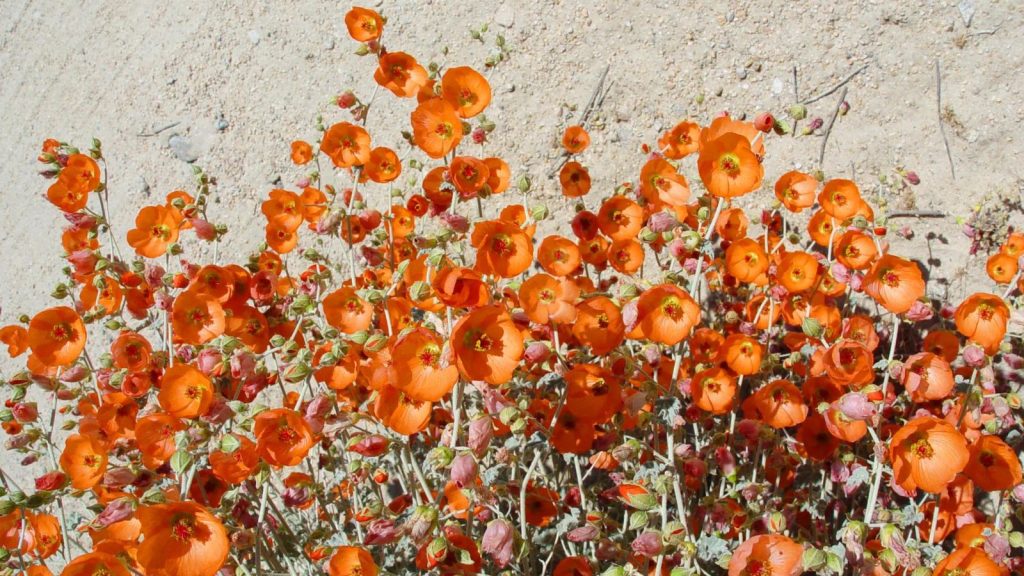
Embracing the arid landscapes, Globe Mallow (Sphaeralcea ambigua) adds a splash of color with its rounded, vibrant flowers.
You’ll detect hues ranging from fiery orange to soft pink, and even bold red, painting the desert canvas.
These resilient plants are at their most impressive during the wildflower season, embodying the essence of a desert blooming season.
If you’re lucky enough to witness these flowers, note their drought-tolerant nature.
Imagine these hardy perennials dotting arid environments where they champion sustainability.
When you’re planning a garden that conserves water, consider these low-maintenance succulents for year-round interest and charm.
11. Joshua Tree
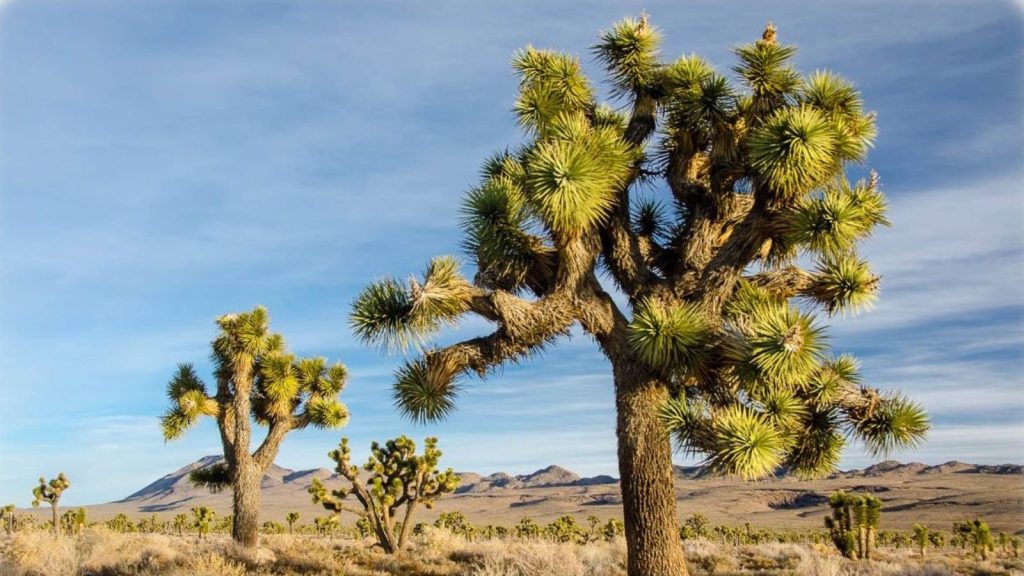
In the heart of the Mojave Desert, Joshua Tree National Park becomes a spectacle during the wildflower season.
Your eyes can feast on the Yucca brevifolia, commonly known as the Joshua tree.
These trees showcase clusters of creamy white flowers that accent the rugged desert landscape.
- When in bloom, Joshua trees offer a striking contrast to the arid environment.
- Blooms depend on the perfect balance of winter rainfall and spring temperatures.
- For the latest updates on the blooming season, check the National Park Service.
It’s not just the Joshua trees that stand out but a variety of desert plants—from shrubs to other flowering desert plants—that all play a part in this intricate ecosystem.
With the right conditions, you’re treated to a show of nature’s resilience as seeds turn into beautiful expressions of life, surviving and thriving in a challenging environment.
Remember, the blooming of flowers is a delicate event that fills the desert with color.
So, plan your visit to capture the Joshua Tree during its remarkable wildflower season.
12. Chuparosa
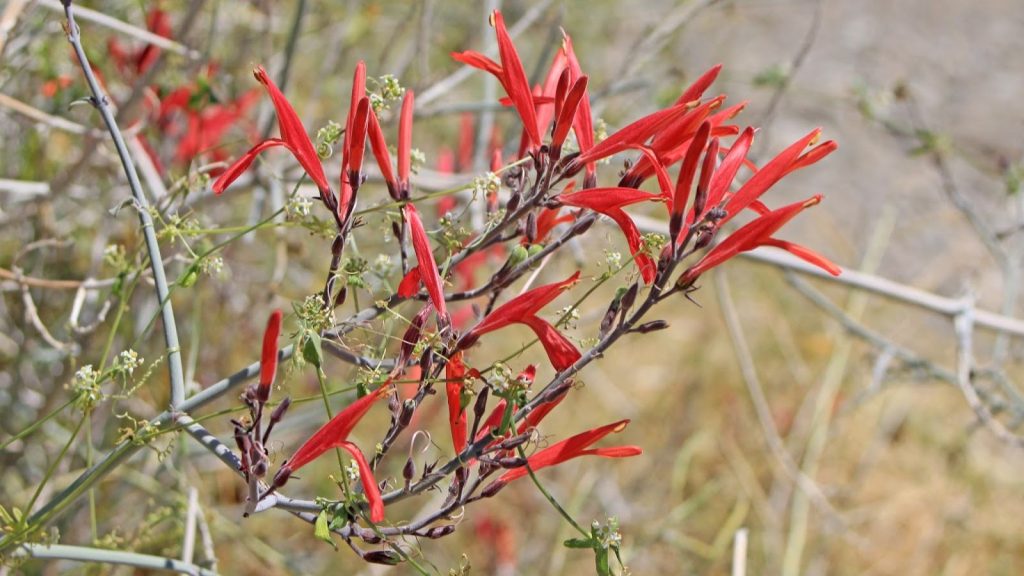
Chuparosa, known scientifically as Justicia californica, graces the arid landscapes of California with its vibrant display.
These plants are a sight to behold with their bright red to orange tubular flowers, which come into full bloom captivating not only your sight but also attracting hummingbirds far and wide.
Characteristics:
- Flowers: Tubular, red or orange
- Attraction: Hummingbirds
- Bloom Season: Peaks in early spring
As you wander through the wildflower displays, the sight of Chuparosa adds a splash of color against the earthy desert backdrop.
It’s a quintessential component of California’s wildflower panorama.
Enjoy the beauty of these desert dwellers, and don’t forget to look out for the dances of the hummingbirds they so lovingly entertain.
13. Penstemon
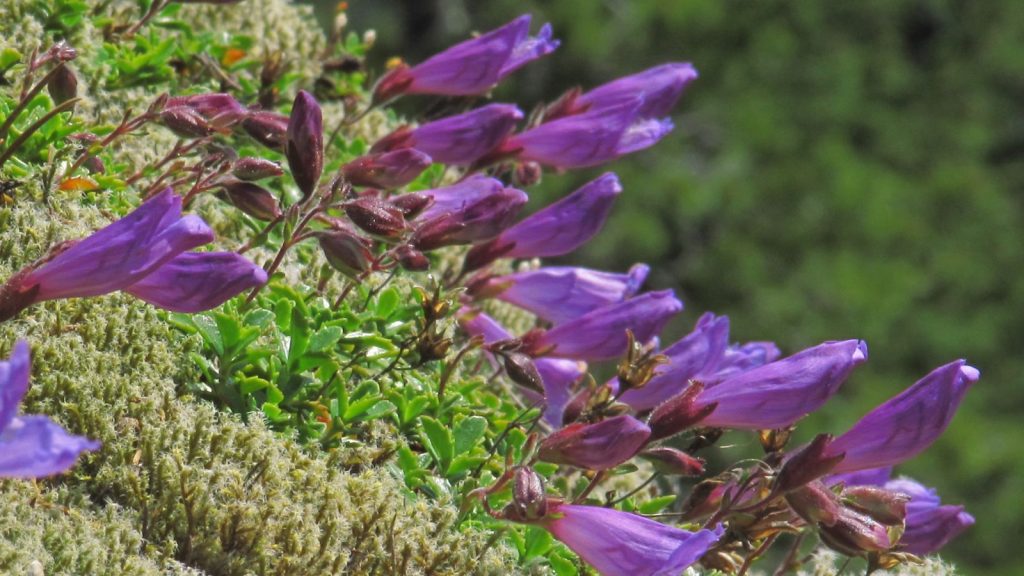
Discover the stunning beauty of Penstemon spp., commonly known as beardtongues, which grace arid landscapes with their vibrant tubular blossoms.
These wildflowers offer a spectrum of hues—radiant reds, soft pinks, deep purples, and brilliant blues.
Each year, their colorful blooms enliven the desert with a visual symphony, elevating it from a barren expanse to a kaleidoscope of life.
Quick Facts:
- Flower Shape: Tubular
- Color Range: Red, Pink, Purple, Blue
- Common Name: Beardtongues
When you encounter these resilient blooms, you’re witnessing one of nature’s splendid adaptations.
Penstemons thrive in challenging conditions, adding a touch of grace to the rugged desert.
Their flowers don’t just catch your eye—they captivate hummingbirds and pollinators too, adding vibrancy to the ecosystem.
Embrace the chance to witness their bloom; they’re a testament to the desert’s hidden wonders.
14. Red Yucca
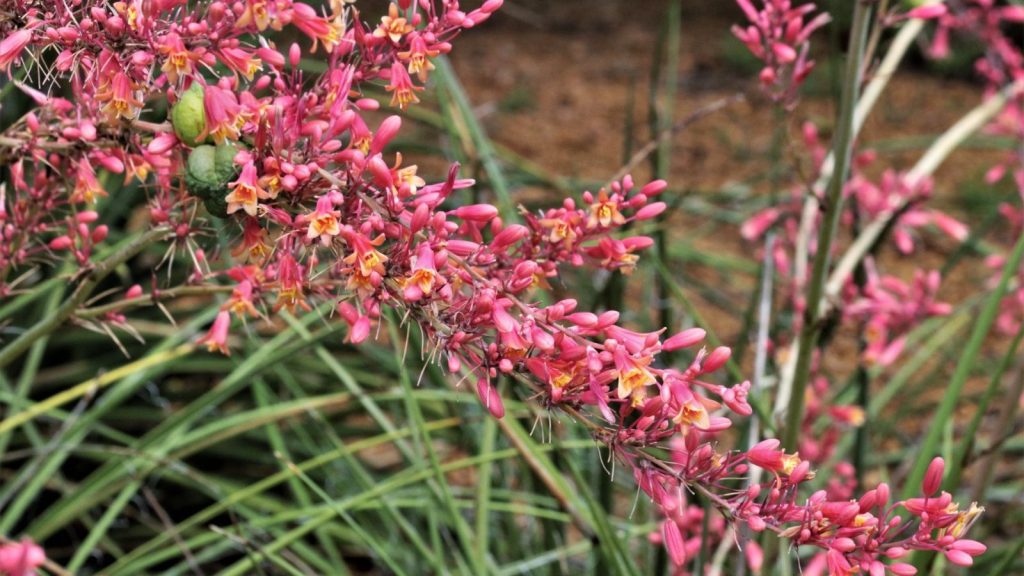
Botanical Name: Hesperaloe parviflora
Imagine your garden graced by the Red Yucca, a plant that isn’t truly a yucca but enchants with its coral-hued, tubular blossoms.
These hardy flowers emerge on slender spikes, creating a vibrant display.
Growing Region: In Arizona, these striking plants are well-adapted to the desert climate, showcasing their resilience and adding a unique flair to arid landscapes.
Blooming Season: You’ll witness the beauty of their bloom predominantly in the spring and early summer, transforming the desert with bursts of color.
Characteristics:
- Foliage: Blue-green leaves, 2-3 ft long
- Flowers: Coral-colored, tubular, attracting hummingbirds
- Maintenance: Minimal, occasional pruning needed
During the dormant months, you won’t see much activity, but once conditions are right, prepare to be amazed by their striking spikes.
These plants, akin to a cactus in their love for the heat and drought tolerance, are perfect for gardeners who appreciate low-maintenance yet stunning floral scenes.
15. Brittlebush
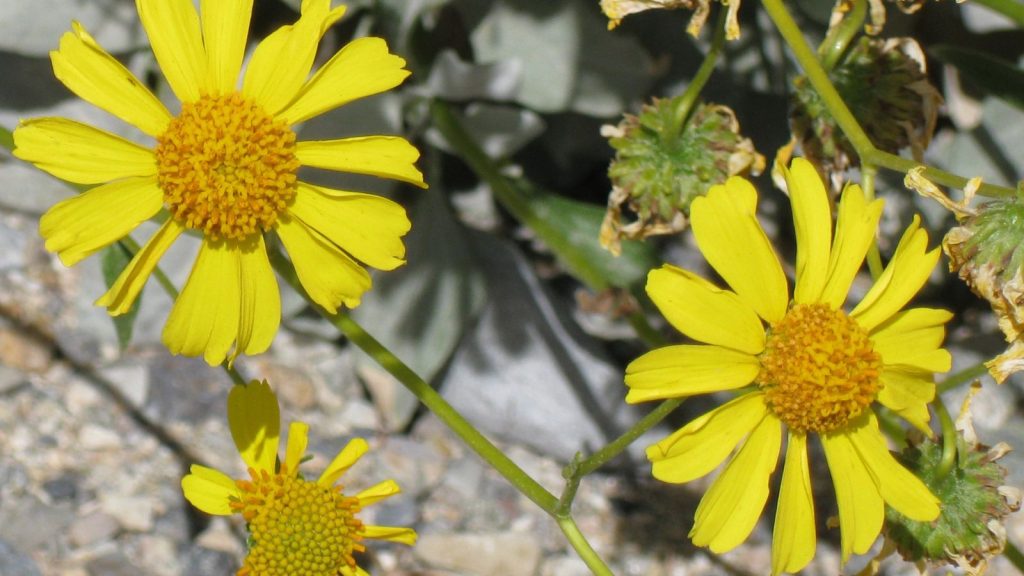
Encelia farinosa, commonly known as brittlebush, is a resilient wildflower that transforms arid landscapes into a vibrant spectacle.
During the peak wildflower season, you’ll notice its silver-gray leaves and striking yellow blooms that resemble daisies.
In the warmth of Arizona’s deserts, these plants thrive, taking full advantage of the sunny climate.
The blooms of the brittlebush typically emerge from late winter to mid-spring, a period when the desert is awash with color.
You’ll find them in full bloom when temperatures are mild, and their presence signals a lively yet serene desert ambiance.
As a desert dweller, you might see these flowers lining dry washes and sandy flats, adding a splash of cheer to the otherwise stark surroundings.
- Flower: Bright yellow, daisy-like
- Foliage: Silver-gray
- Habitat: Deserts of Arizona
- Season: Late winter to mid-spring
The Encelia farinosa represents not just the hardiness of desert flora but the beauty that can emerge from the most unexpected places.
Its ability to stand out in the harsh conditions is a testament to nature’s resilience.
Enjoy the sight of these sunny flowers and the warmth they bring to the expansive desert canvas.
16. Mojave Aster

In the vast expanses of the Mojave Desert, Xylorhiza tortifolia, commonly known as the Mojave aster, showcases its unique beauty.
With its vibrant purple petals encircling a bright yellow core, these flowers flourish under the California sun.
Native to this particular desert, Mojave asters belong to the aster family, known for their daisy-like appearance.
As you explore the flowering desert during the wildflower season, these perennial shrubs can serve as a spectacular sight.
Typically, flowering occurs from early spring to late summer, marking a period when the arid landscape transforms into a canvas of color.
- Appearance: Purple petals with a yellow center
- Location: Mojave Desert, California
- Blooming Season: Early spring to late summer
Mojave asters are a true testament to the resiliency of desert flora.
17. Fishhook Barrel Cactus Flower
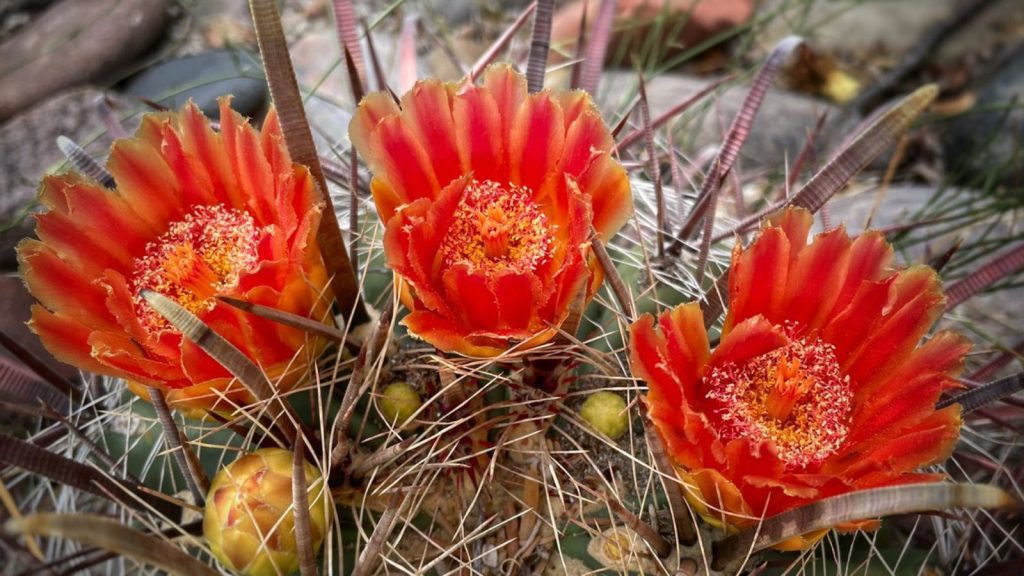
Imagine wandering through the vast arid landscapes of California or Arizona and stumbling upon the vibrant spectacle of the Fishhook Barrel Cactus’ flowers.
These cacti, seemingly dormant, come alive with a brilliant show of colors as the temperature rises.
Their crowning glory is the ring of bright red, orange, or yellow flowers encircling their tops.
- Bloom Season: Late spring to summer
- Flower Colors: Red, Orange, Yellow
During a super bloom, when conditions after rainfall are just right, the desert transforms as various species of cacti, including the beloved Fishhook Barrel Cactus, spectacularly flower, turning the landscape into a painter’s palette.
Embrace the warmth as these hardy cacti celebrate the harsh arid conditions with a fiery display of life.
18. Chocolate Daisy
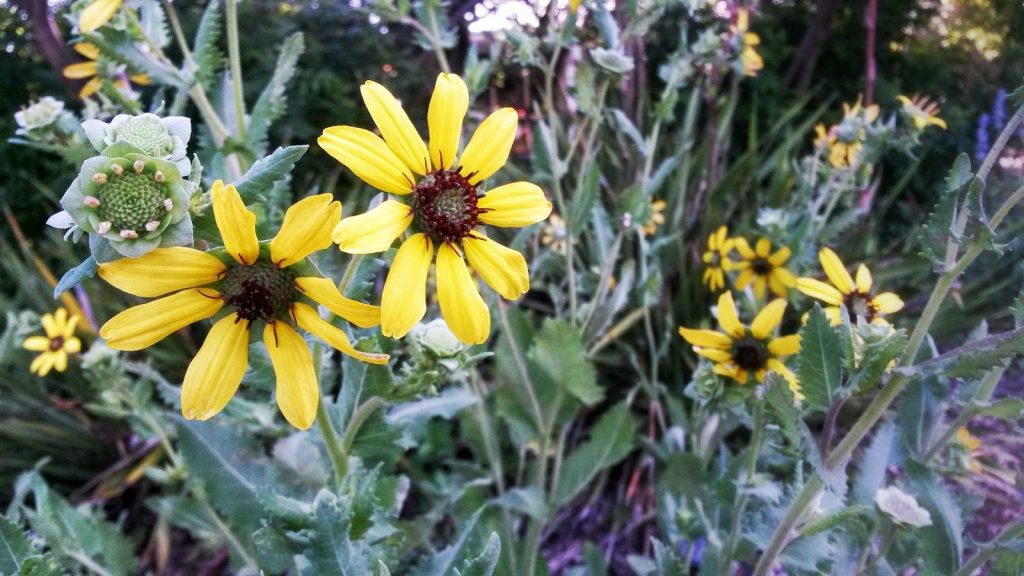
The Chocolate Daisy (Berlandiera lyrata) is a delightful addition to any arid landscape.
Imagine waking up to daisy-like flower heads with bright yellow rays that complement deep maroon centers.
It’s no surprise they’re often referred to as the chocolate-scented flowers due to their unique aroma, especially noticeable in the morning.
- Bloom time: Spanning from late spring to fall.
- Temperature: Thrives in warm weather; becomes dormant in colder seasons.
Your garden will not only look vibrant but also become a haven for pollinators.
As you nurture these wildflowers, ensure they have ample sunlight to encourage bud formation.
Once sown, the seeds may germinate when the temperature is just right, giving rise to new growth.
Caring for your Chocolate Daisy plants requires minimal effort.
Just give them the space to bask in the sun and watch as they infuse your garden with a touch of chocolate allure.
19. Blue Palo Verde
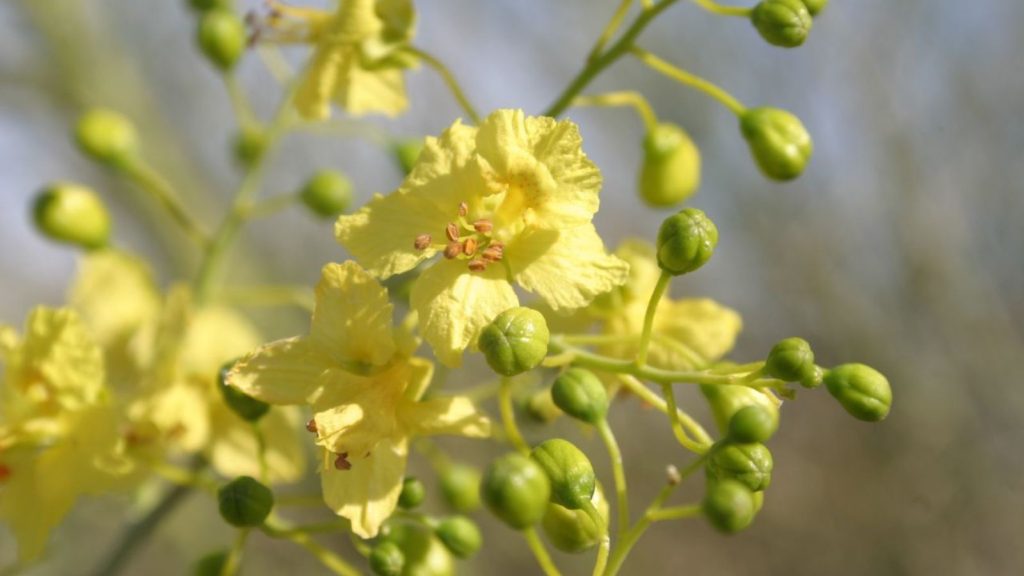
When you step into the vibrant desert landscapes of California and Arizona, particularly when temperatures rise, you’ll be welcomed by the radiant blooms of the Blue Palo Verde (Parkinsonia florida).
Recognized as the Arizona state tree, this desert dweller is celebrated for its distinctive green bark and brilliant yellow flowers that herald the wildflower season.
These trees are not just important for their beauty but are crucial for the ecosystem, providing shelter and aiding in the growth of other species, like the iconic saguaro cactus.
Through their role in the landscape, they make arid conditions hospitable for diverse plant life, creating pockets of lushness that defy the harsh climate.
During bloom, Blue Palo Verdes transform the desert landscape into a canvas of gold, creating striking contrast with the azure sky.
If you’re in these states during wildflower season, look out for the flourishing sunny canopies of the Blue Palo Verde; they are a sight that truly encapsulates the spirit of the desert.
20. Ghost Flower
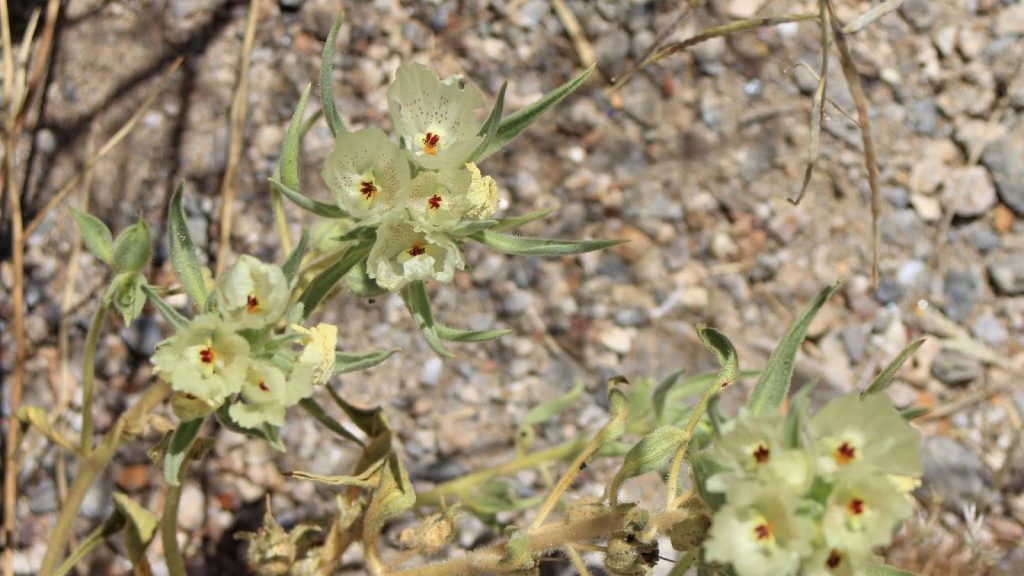
Encounter the Mohavea confertiflora, commonly known as the Ghost Flower.
This ethereal desert bloom thrives in the California landscape.
You’ll notice its cream or pale yellow petals that gently showcase reddish markings, evoking the image of an open mouth ready to consume the sunlight.
Quick Facts:
- Family: Plantaginaceae
- Habitat: Desert washes, rocky slopes
- Bloom Period: February to April
- Elevation: Below 2,500 feet
As one of the ephemerals in the desert, the Ghost Flower’s appearance is a fleeting spectacle.
You’re likely to spot them in full bloom when the conditions are just right, usually following winter rains.
To stay informed on the status of these and other wildflowers, consider dialing into the wildflower hotline.
This way, you won’t miss out on experiencing these natural desert gems in their prime.
Leave a Reply